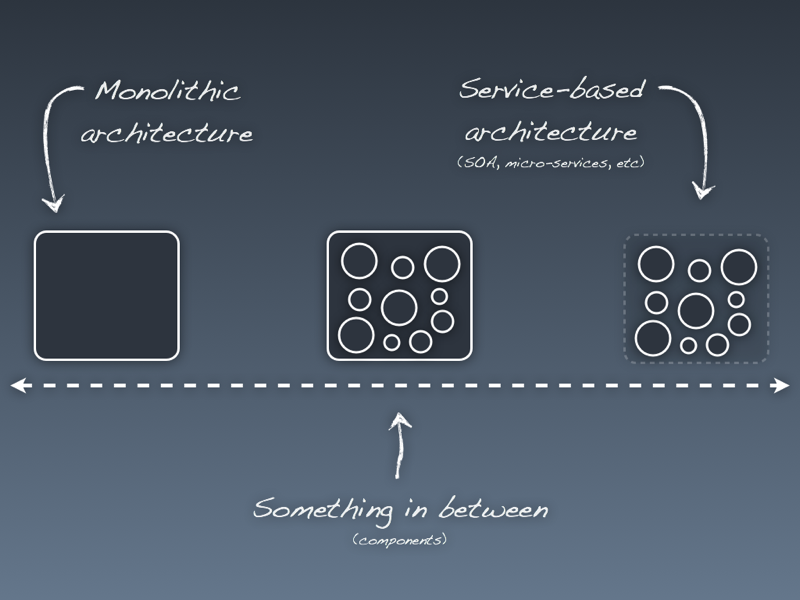Distributed Big Balls of Mud
Join the DZone community and get the full member experience.
Join For Freeif you want evidence that the software development industry is susceptible to fashion, just go and take a look at all of the hype around microservices. it's everywhere! for some people microservices is "the next big thing", whereas for others it's simply a lightweight evolution of the big soap service-oriented architectures that we saw 10 years ago "done right". i do like a lot of what the current microservice architectures are doing, but it's by no means a silver bullet. okay, i know that sounds obvious, but i think many people are jumping on them for the wrong reason.

i often show this slide in my conference talks, and i've blogged about this before , but basically there are different ways to build software systems. on the one side we have traditional monolithic systems, where everything is bundled up inside a single deployable unit. this is probably where most of the industry is. caveats apply, but monoliths can be built quickly and are easy to deploy, but they provide limited agility because even tiny changes require a full redeployment. we also know that monoliths often end up looking like a big ball of mud because of the way that software often evolves over time. for example, many monolithic systems are built using a layered architecture, and it's relatively easy for layered architectures to be abused (e.g. skipping "around" a service to call the repository/data access layer directly).
on the other side we have service-based architectures, where a software system is made up of many separately deployable services. again, caveats apply but, if done well, service-based architectures buy you a lot of flexibility and agility because each service can be developed, tested, deployed, scaled, upgraded and rewritten separately, especially if the services are decoupled via asynchronous messaging. the downside is increased complexity because your software system now has many more moving parts than a monolith. as robert says, the complexity is still there, you're just moving it somewhere else .
there is, of course, a mid-ground here. we can build monolithic systems that are made up of in-process components, each of which has an explicit well-defined interface and set of responsibilities. this is old-school component-based design that talks about high cohesion and low coupling, but i usually sense some hesitation when i talk about it. and this seems odd to me. before i explain why, let me quote something from a blog post that i read earlier this morning about the rationale behind a team adopting a microservices approach.
when we started building karma, we decided to split the project into two main parts: the backend api, and the frontend application. the backend is responsible for handling orders from the store, usage accounting, user management, device management and so forth, while the frontend offers a dashboard for users which accesses this api. along the way we noticed that if the whole backend api is monolithic it doesn't work very well because everything gets entangled.
the blog post also mentions scaling, versioning and multiple languages/frameworks as other reasons to choose microservices. again, there are no silver bullets here, everything is a trade-off. anyway, "everything getting entangled" is not a reason to switch from monoliths to microservices. if you're building a monolithic system and it's turning into a big ball of mud, perhaps you should consider whether you're taking enough care of your software architecture. do you really understand what the core structural abstractions are in your software? are their interfaces and responsibilities clear too? if not, why do you think moving to a microservices architecture will help? sure, the physical separation of services will force you to not take some shortcuts, but you can achieve the same separation between components in a monolith. a little design thinking and an architecturally-evident coding style will help to achieve this without the baggage of going distributed.
many of the teams i've spoken to are building monolithic systems and don't want to look at component-based design. the mid-ground seems to be a hard-sell. i ran a software architecture sketching workshop with a team earlier this year where we diagrammed one of their software systems. the diagram started as a strictly layered architecture (presentation, business services, data access) with all arrows pointing downwards and each layer only ever calling the layer directly beneath it. the code told a different story though and the eventual diagram didn't look so neat anymore. we discussed how adopting a package by component approach could fix some of these problems, but the response was, "meh, we like building software using layers".
it seems as if teams are jumping on microservices because they're sexy, but the design thinking and decomposition strategy required to create a good microservices architecture are the same as those needed to create a well structured monolith. if teams find it hard to create a well structured monolith, i don't rate their chances of creating a well structured microservices architecture. as michael feathers recently said, " there's a bit of overhead involved in implementing each microservice. if they ever become as easy to create as classes, people will have a freer hand to create trouble - hulking monoliths at a different scale. ". i agree. a world of distributed big balls of mud worries me.
Published at DZone with permission of Simon Brown, DZone MVB. See the original article here.
Opinions expressed by DZone contributors are their own.

Comments